Looking for the ultimate ‘Best Moka Pots‘ to recreate the classic Italian coffee experience? Delve into the world of these iconic stovetop coffee makers, also known as “macchinetta” or “caffettiera.” Moka pots offer a straightforward yet effective method for brewing robust, aromatic coffee that embodies the essence of Italy.
In this guide, we’ll unveil the top choices that bring the heart of Italy into your kitchen, ensuring a delightful coffee ritual with every brew. Whether you’re a seasoned coffee connoisseur or a newcomer to the world of brewing, let us guide you through the best Moka pots available, each designed to fulfill your desire for a perfect cup of espresso-like coffee.
-
1.
Our Handpicked Best Moka Pots
- 1.1. 1. Bialetti 6633 6 Cup Moka Stovetop Espresso Maker
- 1.2. 2. Bialetti 06661 Kitty Espresso Coffee Maker, Stainless Steel, 6 cup
- 1.3. 3. Alessi Espresso Maker 9090 by Richard Sapper, 6 Espresso Cups
- 1.4. 4. Cuisinox Roma 6-cup Stainless Steel Stovetop Moka Espresso Maker
- 1.5. 5. GROSCHE Milano Steel 6 cup Stainless Steel Stovetop Espresso Maker Moka Pot
- 1.6. 6. bonVIVO Intenca Stovetop Espresso Maker
- 1.7. 7. DELONGHI EMK6 for Authentic Italian Espresso, 6 cups
- 1.8. 8. Sasso Moka Pot Espresso Maker
-
1.9.
How To Choose Your Own Moka Pot?
- 1.9.1. What is a Moka Pot?
- 1.9.2. How do Moka pots work?
- 1.9.3. The chambers explained
- 1.9.4. What Are Moka Pots Made of?
- 1.9.5. Aluminum Moka pots
- 1.9.6. Stainless steel Moka pots
- 1.9.7. Which material is better – aluminium or stainless steel?
- 1.9.8. Stovetop types – (Check if your Moka pot is compatible)
- 1.10. Gas stovetop
- 1.11. Induction stovetop
- 1.12. Closing Thoughts on Best Moka Pots
- 1.13. FAQ’s about Moka Pots
- 1.14. What is a Moka Pot?
- 1.15. How does a Moka Pot work?
- 1.16. What type of coffee does a Moka Pot produce?
- 1.17. What grind size is best for Moka Pots?
- 1.18. Can I use Moka Pot on an induction stovetop?
- 1.19. How to use a Moka pot?
- 1.20. How to clean a Moka pot?
- 1.21. Is Moka coffee as strong as espresso?
- 1.22. Are Aluminum Moka pots safe?
- 1.23. What are the common mistakes when using a Moka Pot?
- 1.24. Is Moka coffee bitter?
Our Handpicked Best Moka Pots
1. Bialetti 6633 6 Cup Moka Stovetop Espresso Maker
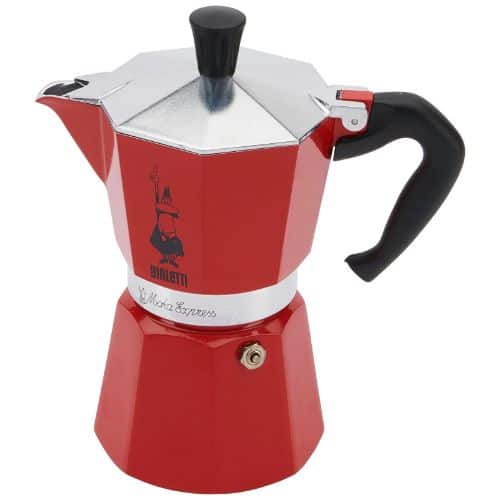
Bialetti is the most famous manufacturer of stovetop espresso makers in the market. This Italian-based company has more than 80 years of manufacturing experience, and its products are most peculiar for their classic design, technological simplicity, and low price.
The company boasts over 200 million manufactured coffee makers and its Moka Expresso is one of its most iconic products.
The 6633 Moka Espresso maker is a 6-cup pot that comes with an elegant octagonal design, and brilliant finish. Its eight-sided shape does more than just design; it allows heat to diffuse efficiently to enhance the aroma and taste of the coffee.
The build of this machine is of lightweight, durable, and polished Food Grade Aluminum Alloy that makes coffee making with this pot both easy and quick. Speaking of brewing speed, this Moka pot can produce up to six cups of coffee in less than five minutes.
Although the product is neither for induction stove use nor it is dishwasher safe, it is suitable for stovetops and easy to hand wash. It is also easy to disassemble but make sure all parts are completely dry before reassembling, to prevent oxidation.
Lastly, the pot comes with a 2-year warranty from its date of purchase.
Pros
- Durable construct
- Stylish Italian design and excellent finish
- Brewing comes easily and quickly with this Moka pot
Cons
- Not dishwasher safe
- It is not suitable for induction cooktops
2. Bialetti 06661 Kitty Espresso Coffee Maker, Stainless Steel, 6 cup
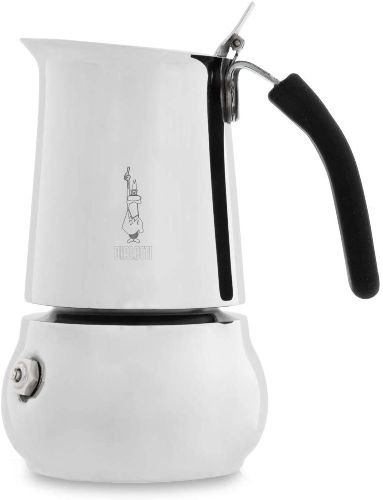
As much as we intend to be transparent in our selection, we couldn’t help but include this product from Bialetti. Yes, they are just that good.
The 06661 Kitty Espresso maker is very much the opposite of the 6633 stovetop maker in so many ways. Albeit, this product still features a brightly finished exterior and a classy design (and they have the looking logo, too).
This pot comes in a durable, rust-proof Stainless steel construction, and it is compatible with gas, ceramic, and electric stovetops. Although it is not entirely dishwasher safe, some of its parts –gasket, Filter, Funnel – are suitable for dishwashing.
The taste of the coffee from this device is smoother than that of most competitors. Its design allows for easy operation and its built-in, heat-resistant ergonomic handles count as a plus on its overall ease and safety of use.
It is also worth mentioning that this coffee maker is an induction safe, and its maximum boiler capacity is 300ml. However, for results, do not use too fine ground coffee. The device is induction-safe and still has the Bialetti two-year warranty.
Pros
- Elegant design
- Construct
- Induction safe
Cons
- It is not entirely dishwasher-safe
3. Alessi Espresso Maker 9090 by Richard Sapper, 6 Espresso Cups
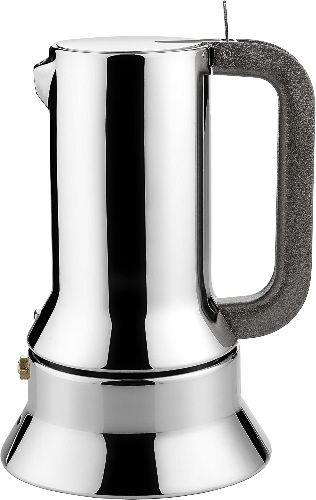
Alessi is an Italian-based company aimed at manufacturing the most advanced build, aesthetics, and functional quality. Founded in 1921, the company gradually evolved into one of the leading factories of Italian design, and its products reflect experience and excellence.
The Alessi 9090 is the first espresso maker and the most popular product from its manufacturer. Its designer, Richard Sapper, aimed to give this percolator the features that competitors did not have. So, you can expect much from it.
First, the device comes with an enlarged base that maximizes the heat. It also features drip sprout pouring, and it has a lock lever that allows you to open the pot easily.
The pot comes in a durable 18/10 stainless steel construct. It has a magnetic steel bottom that makes it ideal for induction cooking. Overall, the pot is compatible with stove, electric, gas, and induction cooking.
There is an ergonomic, heat-resistant handle for grip as well as a lever for unlocking the pot. It is not dishwasher safe, but hand washing the device is easy and preferable.
Although this product is quite expensive – more than five times the price of the Bialetti 6633, its features and construct justify it.
Pros
- Thoughtful, sleek, and brilliant design
- Suitable for all types of cooktop
- Easy to wash and disassemble
Cons
- Not dishwasher safe
4. Cuisinox Roma 6-cup Stainless Steel Stovetop Moka Espresso Maker
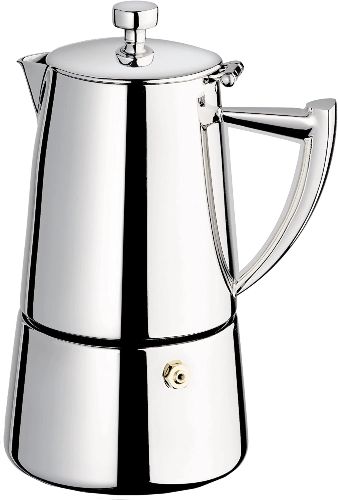
Cuisinox is a France-based manufacturer of a vast array of upscale stainless steel kitchenware. The company boasts of having products handcrafted from the highest grade of stainless steel that is both bisphenol A, lead, and toxic-free.
The Cuisinox Roma espresso maker has a premium-grade design and a distinguished style handcrafted to the highest possible standard in the industry. It features a sturdy, rust-proof 18/10 stainless steel design that significantly increases its durability, and its exterior comes in a mirror polish finish.
The pot is compatible with all types of cooktops, and it has an induction base specifically for induction cooking. Like every other good Moka pot, this one features a drip sprout design for efficiently pouring out your coffee without dripping some of it.
There is an extra gasket and reducer included in the pot, but you would not need them as all its parts are long-lasting. To add, the coffee maker has a warranty in the market- a 25-year warranty on manufacturer’s defects.
Pros
- Excellent warranty
- High-quality construct.
- Classic and mirror-polished finish
Cons
- The handles may heat up
5. GROSCHE Milano Steel 6 cup Stainless Steel Stovetop Espresso Maker Moka Pot
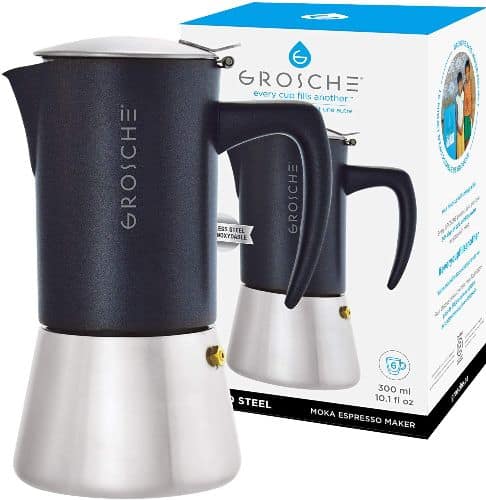
Grosche is a coffee and tea accessory industry gradually taking the world of the beverage by storm. The company only started in 2006. Yet its products are of equal or better construction standards and as feature-rich as products from older manufacturers. The
Milano steel espresso maker comes with a durable stainless steel construct. Its design -the satin finish, the subtle curve on the handle, and the matte black powder coating on the top shimmer excellent and premium quality.
The pot is compatible with all types of cooktops, including the induction cooktop and electric coil stoves. More so, all its parts are dishwasher safe- unlike most competitors. It has a non-drip spout for efficient serving and a durable steel hinge on its cover.
Its bottom comes in heavy gauge steel for improved durability, and it has a certified safety valve made in Italy.
Overall, this product is an excellent blend of quality, luxury, and features, and it is affordable.
Pros
- construct
- Suitable for all cooktops
- Classy design
Cons
- It leaks if you don’t pour it properly (swerving too hard and fast)
6. bonVIVO Intenca Stovetop Espresso Maker
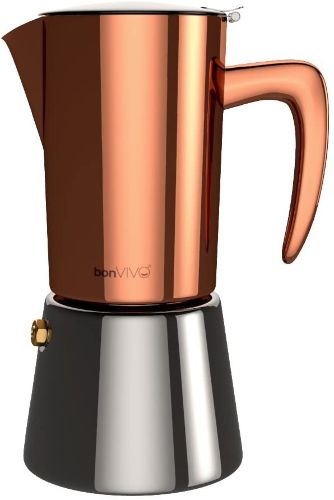
Luxurious Italian Coffee Machine Maker, Stainless Steel Espresso Maker Full Bodied Coffee, Espresso Pot For 5-6 Cups.
bonVivo brand manufactures a wide range of kitchen and home accessories with high-quality construction and an excellent sense of style.
At a glance, this espresso maker is a sleek-looking device with a brilliant touch of class. Upon closer analysis, the pot is a stainless steel device suitable for all cooktop types that can produce a full-bodied aromatic cup of espresso.
The standout feature of this device is its hard-wearing chrome finish. Beyond looks, this finish makes the product last longer than the average Moka pot.
Like other good pots, this one has a U-U-style spout that allows for easy pouring of coffee and little or no dripping. It also features a heat-resistant handle that allows you to pick up the device without getting burnt.
Sadly, the device is not safe for dishwashing. Yet, you can use soapy water to hand wash the pot easily.
Pros
- Sleek design
- Premium look and quality
- Chrome finishing for improved durability
- Suitable for all cooktops
Cons
- It is not dishwasher safe
7. DELONGHI EMK6 for Authentic Italian Espresso, 6 cups
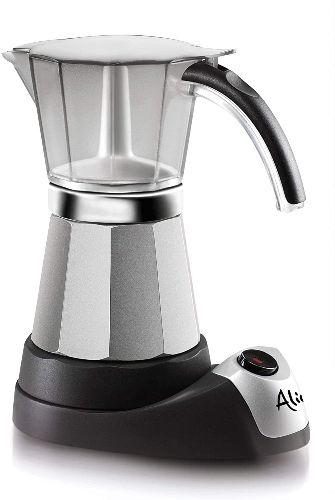
Delonghi is an Italian-based manufacturer whose product shimmers a thoughtful design and elegant construction. As with all its products, the EMK6 espresso maker comes with a unique build.
Precisely, this product is an electrical coffee pot that produces tasty cups of Italian coffee within minutes. With this electrical design, you wouldn’t have to worry about burning your coffee. Specifically, there is an automatic shutdown feature that turns off the machine immediately after the brew is complete.
Also, the device comes in a transparent container that allows you to monitor the entire brewing process. You can also stop the brewing at any time with its easy operational switch at its base.
For easy movement and serving, you can easily detach the jug from its base for a cord-free serving. There is also another automatic shutdown feature that turns off the machine when the jug lifts from its base.
Overall, this aluminum and glass device is an easy and safe option for Moka brewing. It is easy to operate and of high durability.
Pros
- Easy to operate
- It allows complete monitoring of the brewing process
- It is affordable
Cons
- Its use is limited to only places with power supply
8. Sasso Moka Pot Espresso Maker

This product comes in a design very different from any other Moka pot in the market. However, design alone is not all there is to it.
First, the pot comes in aluminum with a solid-cast body that allows for fast and even distribution of heat, producing a rich, strong espresso.
As with every other aluminum Moka pot, this one is compatible with gas, electric, and ceramic stoves. However, it is not suitable for induction cooktops. The device features a heat-proof, soft-touch, timber-look, ergonomic handle that will neither get hot nor melt when preparing your cup of joe.
It also comes with a safety valve at its bottom to prevent the building up of pressure. Although you may have to wait for years to use it, the device has a spare basket for replacement when it becomes bad.
All in all, this device has a build for durability and luxury, and it is very affordable.
Pros
- Exquisite look
- High durability
- Drip-sprout design
Cons
- It is not dishwasher-safe
- It is not suitable for induction stoves
These Italian percolators are similar to real espresso makers in a way that they, too, use pressure to filter the water through the coffee grounds, to extract their flavour of them into the water. These coffee percolators use significant lover pressure of around one to two bars. Compared with an espresso maker, which produces and uses at least eight to nine bars of pressure when brewing a shot of espresso. They still manage to brew a cup of strong, vibrant, and flavorful cup of coffee with a pinch of the specific creaminess that you get from an espresso machine.
This is certainly a great way to start your mornings, especially when you have a long day ahead. One of these pots can change your entire morning routine and put you in a great mood.
How To Choose Your Own Moka Pot?
Moka pots are the thing when it comes to brewing a simple, but elegant, full in flavor and creamy cup of coffee. The Moka pots can be hard to find, so here is a guide to ease your journey into the world of stovetop coffee makers.
What is a Moka Pot?

The Moka pot was invented by an Italian engineer named Alfonso Bialetti in 1933. The name of this little stovetop percolator he borrowed from the Yemen city of Mocha, where it was made at the time. The Moka pot quickly became very popular among Italians, forming its coffee drinking habits and the very culture.
A Moka pot is a coffee maker that can be brewed on both – a stovetop or electrically. It uses pressure to push the water through ground coffee beans, extracting the flavor, enzymes, and oils into what you know as Italian espresso or any other espresso-based drink. Can a Moka pot actually brew espresso shots? Not really, its pressure is way below what a dedicated espresso maker produces (and that it needs for the drink to qualify as an espresso), but it brews a very similar drink.
Traditionally Moka pots were made of aluminum. Mostly because, at the time, that was the most common material that could be bent and transformed easily enough to the shapes required for the coffee percolator. Nowadays, however, more and more Moka pots are made of stainless steel.
How do Moka pots work?
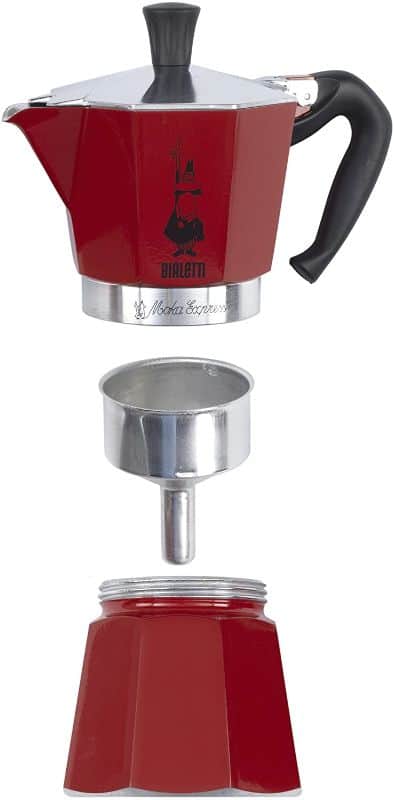 The main parts of a Moka pot consist of three chambers, a safety valve, and a filter. The three chambers are meant for coffee grounds, water, and the resulting coffee brew.
The main parts of a Moka pot consist of three chambers, a safety valve, and a filter. The three chambers are meant for coffee grounds, water, and the resulting coffee brew.
The chambers explained
Let’s start from the bottom. The bottom chamber is where you would pour the water. You need to pour the water just below the valve level. If you go over the valve – the excess steam will have no escape route. In case there is too much of it building inside due to too much heat. In that case – the steam will have to go through the filter, causing an over-extraction of the coffee and ruining the taste.
On the upper side of the water chamber sits another chamber for the coffee grounds. In this chamber, you would insert the coffee grounds. The water boiling in the first chamber would produce steam, this steam would press tiny particles (and itself) through the coffee grounds to the upper chamber where it would collect as your coffee drink. It is almost equally important to know how to put the coffee grounds in this chamber. A proper amount of coffee grounds is important – too much or too little may ruin the taste for you. Too much might also cause the grounds to be burnt or pressed too tightly so that the water can not filter through them properly. The use of a coffee tamper is a good way to ensure you don’t press them too tightly. As well as the correct amount.
But before it goes to the third chamber, there is a filter in the middle. Now, I bet you can guess what that is for. In the early days the filter was made of aluminum, and so was the whole Moka pot. Then, the aluminum filter was replaced with a stainless steel one, then – the whole Moka pot was made of stainless steel. Not all of them are, but some are, and some – aren’t. So, the filter will prevent any residue, smaller coffee grounds, or any other impurities from leaching into your final coffee brew.
During this process, the stovetop coffee maker is capable of producing one to two bars of pressure, which is not the level of an espresso maker, but enough to extract all of the flavors from the coffee grounds and into your drink.
What Are Moka Pots Made of?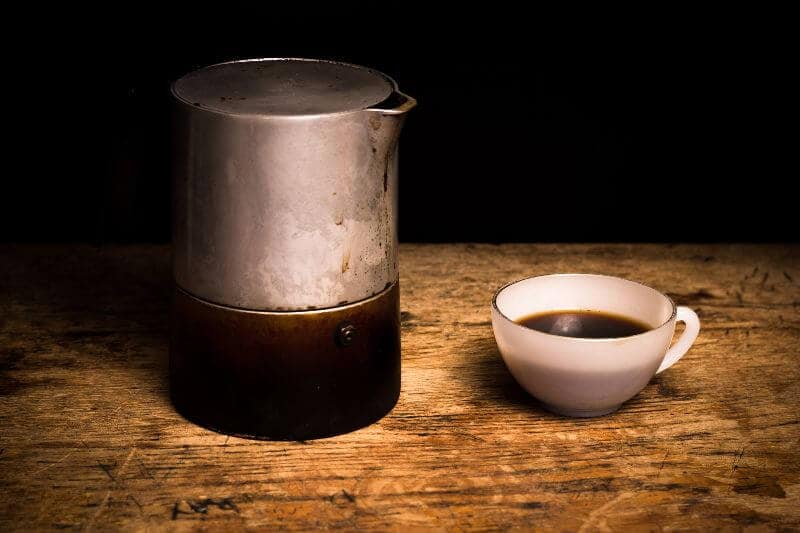
Although the materials may vary, the way they are built stays the same – they still need the same parts, bits, and pieces regardless of the material. But each – aluminium stovetop espresso maker and stainless steel Moka pots – have different properties, pros, and cons.
The bottom line is – that aluminium distributes heat more evenly and better, therefore – coffee in these will turn out to be better. But they are known to impart small amounts of trace metal in your brew. Admittedly it is really an extremely small amount, however, it is still there. Stainless steel Moka pots are safer on the health side, but they do not conduct heat the same way as aluminium. But let’s dig deeper and find out all about that, shall we?
Aluminum Moka pots
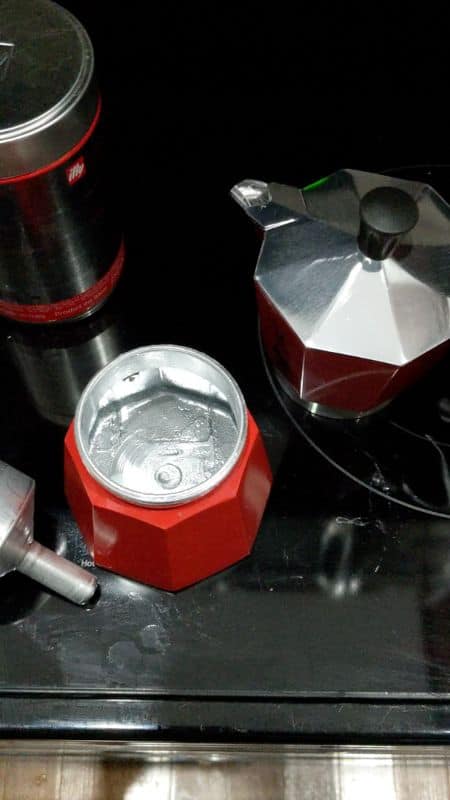 Aluminium stovetop espresso makers have this layer of distrust surrounding them. Many people believe that it is not safe to brew coffee in an aluminium Moka pot. On Coffee Detective there was a discussion regarding whether or not aluminum pots can give us Alzheimer’s disease. As it turns out – no. Although there was a lot of talking about this subject, there is little evidence from the scientists that backs up this statement. Sure, you can always find some small connection if you look hard enough, but this is a phenomenon called “confirmation bias”, which basically means – if you are looking for something specific you will eventually find it. Ignoring the facts and complete scene and focusing only on what you were looking for.
Aluminium stovetop espresso makers have this layer of distrust surrounding them. Many people believe that it is not safe to brew coffee in an aluminium Moka pot. On Coffee Detective there was a discussion regarding whether or not aluminum pots can give us Alzheimer’s disease. As it turns out – no. Although there was a lot of talking about this subject, there is little evidence from the scientists that backs up this statement. Sure, you can always find some small connection if you look hard enough, but this is a phenomenon called “confirmation bias”, which basically means – if you are looking for something specific you will eventually find it. Ignoring the facts and complete scene and focusing only on what you were looking for.
Moka pots traditionally were made of aluminium, one reason for that is that it was cheaper. Another is that it conducts heat really well. The Italian coffee makers that make aluminium Moka pots are Bialetti and Alessi, both included in our Moka pots, they have the experience and skills to make the stovetop coffee makers out there.
Stainless steel Moka pots
Stainless steel Moka pots are a great option, too. And becoming increasingly favoured by coffee connoisseurs, as they are more durable and last longer than aluminium Moka pots. One of the biggest disadvantages of a stainless steel stovetop Moka pot is that it distributes heat less evenly than an aluminium pot does. This might lead to burnt coffee grounds and a bad taste in your coffee cup.
However, they offer a lot in terms of quality, durability, and efficiency, too. Stainless steel contains chromium – an element that prevents corrosion of metal materials. It is also more durable than aluminium, it is not porous and it is way easier to clean and maintain than aluminium. Although stainless steel Moka pots often are more expensive than their aluminium counterparts, it is safe to say that they will also last longer.
Which material is better – aluminium or stainless steel?
So, the bottom line is – both materials are great for everyday use. Although there are rumours about the adverse effects of aluminium pots and kitchenware – those are not proven, on the contrary – are not true. Although they might impart a little metallic taste to your coffee, in most cases that means that you have been using too much heat to brew your shot of Italian espresso. This taste will go away as soon as you start using the correct temperature. Aluminumoka pots are great at conducting heat, better than stainless steel, actually, but are not as durable and are harder to clean and maintain.
Stainless steel stovetop coffee percolators, on the other hand, are becoming increasingly popular due to their durability, anti-corrosion properties, and ease of use, cleaning, and maintenance. They are very similar to the aluminium Moka pots, minus the chance of added metallic taste to your coffee if the heat is too big.
Stovetop types – (Check if your Moka pot is compatible)

Gas stovetop
Gas stovetops are the most versatile coffee maker types. You can use all types of Moka pots here (apart from the ones meant for induction stovetops).
Induction stovetop
The Moka pot for an induction stovetop is a stainless steel one. You can not use an aluminium Moka pot on an induction stovetop as it is not magnetic and, therefore, does not work on induction. However, not all stainless steel stovetop espresso makers are compatible with induction coffee pots. If you own an induction stovetop – check if it is compatible before buying your Moka pot.
The Moka pot size guide – (How many cups do you need?)
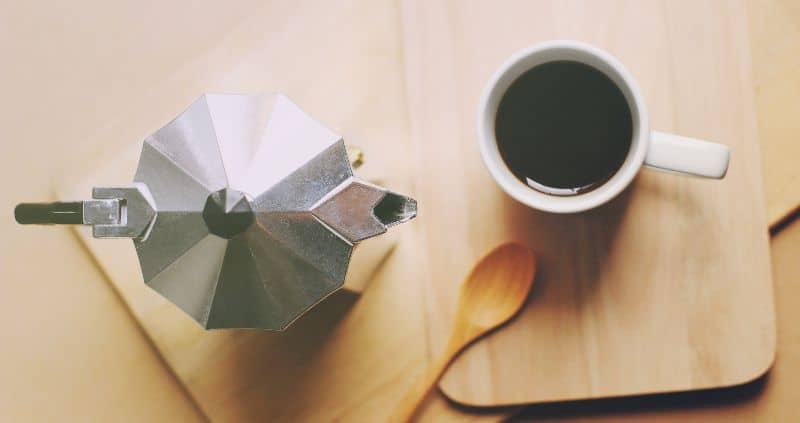
As most Americans think of a cup of coffee as around 6-ounce cups, you might be surprised to order a stovetop coffee maker that states it can fit 2 or 3 cups, just to find out it is way smaller than you expected. As the Moka pot is making Italian coffee, the cup sizes here are meant for espresso. Therefore they are smaller than your average cup size.
Most Moka pots have various sizes, starting from 1 cup and going up to 16 cups. However, there are sizes that are more common among coffee drinkers. For a household of two to three people who drink coffee, a Moka pot of 6-cups size would be a good fit. For example, one of the Moka pots we can recommend is the Cuisinox Roma, which is perfect for 2 or 3 people. A pot with 8 cups or 10 cups will be good for 3 to 4 people.
While larger families should look for bigger Moka pots, like 16 cups. However, if you need a really large Moka pot, perhaps you should consider something else. For example, an espresso maker. Because at some point it will just become too time-consuming and complicated to use a Moka pot for the whole family. Stovetops coffee makers are at brewing small batches of coffee in a brief period of time.
How to take care of your Moka pot?
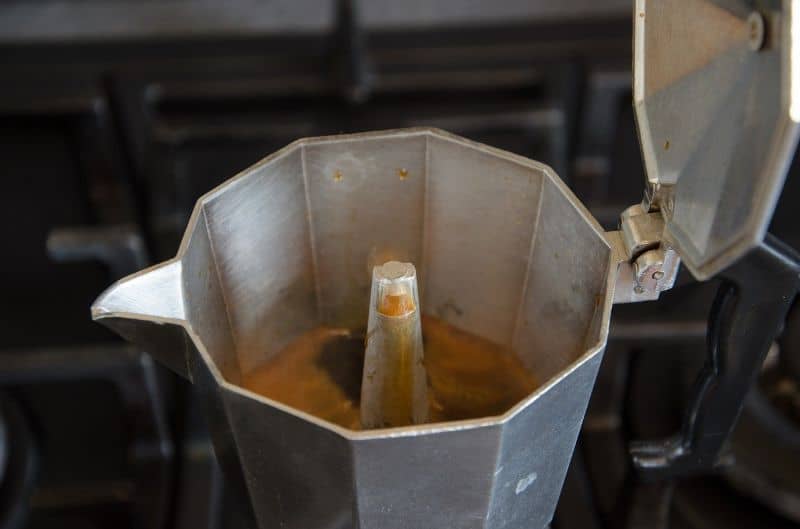
Once you have bought your stovetop espresso maker you will need to take good care of it, so it serves you for a long time. The known way to do that is by doing proper maintenance and cleaning the Moka pot regularly. How to do that? That is why you are here.
First of all – the basics to keep in mind is the proper use of these coffee makers. So you need to make sure you are using your Moka pot on the correct stovetop type. Some of them can not be used on induction stovetops, while others can. Some of them, on the other hand, can’t be used on open flame (mostly because they might have wooden or plastic handles that might burn or melt, or they are coated in a material that can not withstand a direct and open flame. You need to check what your stovetop espresso maker can and can not do – just read the manual or the packaging labels, it should be there.
Cleaning your Moka pot
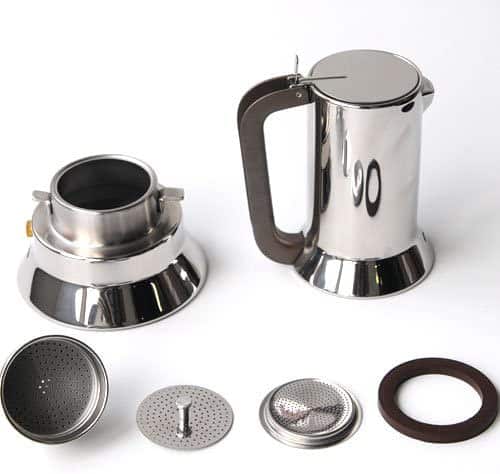 Cleaning the Moka pot should not be too hard. To clean an aluminium Moka pot you should remember that aluminium is a porous material – that means, if you scratch it (and it can scratch quite easily) it can start adding tiny bits of the material to your coffee. The way to go around cleaning aluminium stovetop espresso makers is to wash them by hand, without using any scrapes or detergents. You only need to rinse it with warm water and that is all. This way you will not wash away the seasoning (if we can call it that) of the Moka pot from the previous times you have used it. And, if kept dry and in a dry place after rinsing it – it will be ready for use the next time you need it.
Cleaning the Moka pot should not be too hard. To clean an aluminium Moka pot you should remember that aluminium is a porous material – that means, if you scratch it (and it can scratch quite easily) it can start adding tiny bits of the material to your coffee. The way to go around cleaning aluminium stovetop espresso makers is to wash them by hand, without using any scrapes or detergents. You only need to rinse it with warm water and that is all. This way you will not wash away the seasoning (if we can call it that) of the Moka pot from the previous times you have used it. And, if kept dry and in a dry place after rinsing it – it will be ready for use the next time you need it.
A stainless steel stovetop espresso maker can withstand rougher care, so you can use various dish detergents and scrub to clean it, if necessary.
Most manufacturers also allow the Moka pots to be washed in a dishwasher. However, we would suggest against it, as it can get quite abrasive for the Moka coffee pot. It does not really take that long to clean it. Remember to clean not only the chambers but also the filter and valve.
Also Read: Best Moka Pots | Jura E8 Review | Espresso Machines With Grinders | DeLonghi EC155 Review | Best Miele Coffee Makers | Commercial Espresso Machines | Espresso Machines Under $200 | Manual Espresso machines
Closing Thoughts on Best Moka Pots
So, here you are. I hope this article gave you a good insight into what are the Moka pots – we tried to do what we could with our selections. The buying guide is just there in case you were wondering – what makes a good Moka pot, how to tell them apart, and what to pay attention to when choosing your own stovetop coffee maker.
These things are a great tool for anyone who loves coffee, really. You can use them at home as well as outdoors – nothing better than a freshly brewed cup of espresso-based drink while camping out. They are fairly inexpensive (sure, as with anything else – you can pay more for extra quality, bells, and whistles), but the very basic Moka pot will do its job beautifully. If you need a proper workhorse, try the Bialetti traditionally looking Moka pot. It is number one on our list and approved by thousands of other shoppers, as one of the supreme stovetop coffee makers out there.
Do it any way you like, one thing is for sure is that these Moka coffee pots are a great way to be sure you get that perfect steaming cup each morning. It will help you get out there and achieve your dreams.
We hope this article proved to be useful for you, and, as always, if you have any questions or anything to tell us – write it down in the comment section.
FAQ’s about Moka Pots
What is a Moka Pot?
A Moka pot, also known as a stovetop espresso maker, is a coffee brewing device invented by Alfonso Bialetti in the early 1930s. It consists of three chambers that use steam pressure to brew coffee by passing boiling water pressurized by steam through ground coffee.
How does a Moka Pot work?
The Moka pot operates by heating water in the bottom chamber, creating steam pressure that pushes boiling water through coffee grounds in the middle chamber, extracting coffee into the top chamber.
What type of coffee does a Moka Pot produce?
Moka pots brew a strong and concentrated coffee similar to espresso but not identical. The resulting brew is richer and more intense than drip coffee but lacks the crema layer found in espresso.
What grind size is best for Moka Pots?
A medium-fine grind, similar to table salt in texture, is generally recommended for Moka pots. This grind allows for optimal extraction without clogging the brewer.
Can I use Moka Pot on an induction stovetop?
Traditional aluminum Moka pots don’t work on induction stovetops as they are not magnetic. However, there are stainless steel or specially designed induction-friendly Moka pots available.
How to use a Moka pot?
To use a Moka pot, start by filling the bottom chamber with water, ensuring it’s below the valve. Next, place the second chamber on top and add finely ground coffee. Tighten the third chamber and assemble the Moka pot. Then, place it on the stove, using low to medium heat. Monitor the brewing process, which should take 5 to 10 minutes, and stop once there’s no water left in the bottom chamber. Avoid excessive heat to prevent burning the coffee grounds.
How to clean a Moka pot?
For aluminum Moka pots, avoid using dishwashers, detergents, or abrasive tools. Instead, wash them with warm water and a soft cloth. Stainless steel Moka pots are more durable and can be hand washed or, while not recommended, placed in the dishwasher for cleaning.
Is Moka coffee as strong as espresso?
Moka pot coffee is strong but not as concentrated as true espresso. Espresso machines use higher pressure (9 bars or more) compared to Moka pots, which typically reach 1 to 2 bars. While resembling espresso to some extent, the brewing process and pressure differences result in a distinct taste.
Are Aluminum Moka pots safe?
Yes, Aluminum Moka pots are safe for use. Although they might release some particles into the coffee, the levels are not harmful to humans.
What are the common mistakes when using a Moka Pot?
Common mistakes include packing coffee grounds too tightly, using too high heat, not cleaning the pot thoroughly, or over-extracting the coffee, resulting in a bitter taste.
Is Moka coffee bitter?
Moka coffee can be bitter if the brewing process is not monitored properly. Over-extraction due to prolonged brewing or excessive heat can lead to a bitter taste.

